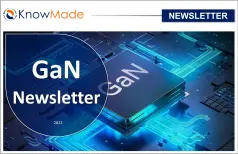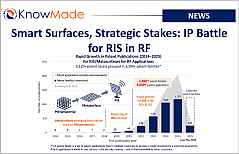The semiconductor industry is on the cusp of a decade of growth
![]()
The semiconductor market is expected to keep growing due to a variety of megatrends, such as digitalization of our system, 5G proliferation, increasing demand for electric vehicles (EVs), autonomous driving, augmented and virtual realities (AR/VR), and wider implementation of artificial intelligence (AI).
In the coming years, the market will be mainly driven by the automotive, computing & data storage, and wireless industries. The automotive semiconductor segment is pushed by the rising need for electrification and self-driving. On the other hand, the computation and data-storage market is driven by the requirement for servers to accommodate cloud computing and AI. In the wireless sector, it is smartphones that will primarily contribute to the growth, supported by 5G expansion. For the next decade, there are new technological prospects in the areas of power management, smart transportation, 5G/6G and IoT, next-generation computing, photonics, AI, quantum, etc.
The semiconductor industry requires long-term investments, and companies invest heavily in R&D projects, striving for innovation across all segments (memory, logic, analog, discrete, optical components, sensors,), as they know distinctive technologies and products is the key to success. Semiconductor companies must develop more sophisticated chips required for advanced computing, mobility, and connectivity applications. While some players focus on developing leading-edge chips with ever smaller node size, others are pursuing “more than Moore” innovations, which involve developing semiconductors devices based on materials other than silicon such as silicon carbide (SiC) and gallium nitride (GaN). Semiconductor packaging is now considered a critical part of semiconductor design and manufacturing, and advanced packaging (fan-out WLP, 2.5D/3D IC, hybrid bonding, chiplets, etc.) now provides a cost-effective way to combine chips at different technology nodes.
Semiconductors are a vital part of differentiating products, and the ongoing chip shortage is prompting certain electronics companies and automotive original equipment manufacturers (OEMs) to do their chip design internally to raise customization and eliminate bottlenecks. As competition increase and chip/device design and production become more intricate, it is increasingly important to better the collaborations within the semiconductor ecosystem, and some companies might pursue a merger and acquisition (M&A) strategy as the industry consolidates.
KnowMade’s purpose
Monitoring and analyzing semiconductor and microelectronics/photonics innovations, from materials and devices to circuits, packaging, and modules/systems, is our mission. Our fields of expertise include power electronics, RF & wireless communications, MEMS technologies, sensing & imaging, photonics, lighting & display, memory, and advanced packaging.
At KnowMade, we strive to help our clients innovate and gain competitive edge they need to stay ahead of the game in technology and intellectual property (IP). Our patent and technology analysis allows us to have a better understanding of the semiconductor industry, and offer our expertise to identify, analyze and track technological innovations, key players and new entrants, as well as their technology roadmap and IP strategy. We also use these insights to spot any potential IP/technology risks or opportunities. We offer a variety of products and services related to the semiconductor field, comprising patent reports, monitors, and customized studies that are designed to meet your needs and budget.
We provide services to a wide range of entities within the semiconductor industry, from material/equipment suppliers and wafer/epiwafer providers, to integrated device manufacturers (IDMs), fabless players, pure play foundries, outsourced semiconductor assembly and test companies (OSATs), start-ups, research organizations, and investors, of all sizes and located all over the globe. We help key decision-makers engaged in the design, manufacture, or supply of semiconductors, microelectronics, and photonics devices, as well as those involved in investing in the semiconductor industry. With the dawn of the Asian century, we are increasingly focused on understanding the implications of China’s growth for our clients’ semiconductor business.
We keep track any patent activities and technology developments related to all semiconductor segments (memory, logic, analog, discrete, optical components, sensors, etc.) and markets (consumer electronics, communication, computing and data storage, automotive electronics, industrial electronics, etc.), with a particular focus on mobility, connectivity, and computing applications.
Some areas of interest for patent analysis
At KnowMade, we give special consideration to innovations in the following areas.
Electrification
Transportation electrification and demand for energy consumption and CO2 emission reduction are an opportunity for power electronics. GaN and SiC have emerged as the most promising candidates to improve efficiency and compactness in a variety of applications such as renewables, power supplies, and transportation.
However, the large-scale adoption of GaN and SiC power electronics devices implies overcoming certain challenges such as building a complete, resilient supply chain, ensuring the performance and reliability of power electronics devices in the critical application fields, and proving cost competitiveness with other solutions at system level. Different development strategies are currently being adopted by GaN and SiC industrial players, either exploring a fabless model, a foundry model or a vertical integration model.
KnowMade’s power electronics teams monitor and analyze any patent developments across the whole value chain, from the crystal growth of bulk and epitaxial materials to the manufacturing of power electronics devices, their packaging and interconnections in sub-systems. We track the players actively engaged in the development of SiC and GaN technologies, including current market players as well as newcomers and those going under the radar. Our patent analysis provides a comprehensive picture of the current and future power electronics competitive landscape, your competitors’ latest R&D activities and roadmap, their target applications and markets.
Automotive and Mobility
Transportation is undergoing its most radical transformation with autonomous, connected, and electric vehicles. The automotive and mobility sector is using more and more semiconductor devices to achieve increased autonomy and communications capabilities. Advanced driver assistance systems (ADAS) and autonomous navigation are driving new perception systems such as LiDAR, imaging RADAR, event-based camera, and the use of sensors (CIS, MEMS, etc.), photonic/optical systems, RF modules, control/calculation chips (MCU, CPU, FPGA, AI chips, etc.), and memories.
KnowMade’s teams look at new trends and innovations coming from semiconductor and electronics devices and modules that meet mobility usage developments. Our products and services give you the ability to monitor and assess global automotive technology trends so that you can develop strategic plans, particularly focusing smart mobility, vehicle-to-everything communication (V2X), autonomy, and electric propulsion.
RF Technologies for 5G & Connectivity
The world is transforming to connect everyone to everything, all the time, making RF components essential for the next generation of connectivity (5G, IoT, V2X, etc.).
5G networks are expected to provide data speeds that are much faster than previous generations of mobile networks, as well as lower latency which is necessary for applications that require real-time responses, and improved reliability in communications. Semiconductors will be critical in delivering the full promise of 5G and beyond. 5G has caused a major increase in the demand for reliable, high-performance RF Front End (RFFE) solutions, the core of mobile communications.
The RF component and module industries offer plenty of growth opportunities, but the established companies are facing strong competition from China where the RFFE ecosystem is quickly developing with many emerging companies supported by the strong domestic demand.
The KnowMade RF team’s daily tasks consist of monitoring and analyzing meaningful technology trends, changes in the competitive environment, and intellectual property strategies of RF companies, covering a variety of topics ranging from RF substrates (such as SOI and POI) to RF devices (including SAW, BAW, XBAR, PA/LNA, and antennas), RF front end modules, and RF advanced packaging (such as FOWLP).
Digitalization and Next Generation Memory Technologies
Memory technology plays a vital role in enabling the digital transformation of our data-centric society, and the needs for memory chips will continue to grow, driven by soaring bit demand from (AI), cloud computing, mobility, and IoT.
High data storage density, bandwidth capability, energy consumption and cost are the critical factors on which current memory technology developments are focusing. The “memory bottleneck” is created as more and more data are transferred between processor and system memory, and new solutions are being developed to bring the data processing unit and memory unit closer together, utilizing 3D-stacked memory architecture and adopting wafer-to-wafer stacking approach (hybrid bonding) to integrate memory and logic chips (advanced IC packaging). The performances can be also improved with in-memory computing, where data are processed within the memory device. As traditional floating gate-based embedded non-volatile memory (eNVM) is becoming more complex, new memory technologies such as FeFETs, MRAM, PCM and RRAM are being heavily explored.
KnowMade’s memory activity is centered around understanding the latest technology innovations and their implementations, alongside the main players’ intellectual property (patents) strategies. The memory teams monitor and analyze any patent developments related to cutting-edge memory components (MRAM, PCM, ReRAM, etc.), new applications (neural networks, neuromorphic computing, etc.), and innovative packaging technologies (hybrid bonding, etc.).
Semiconductor Advanced Packaging
Advanced packaging group a variety of different techniques, including fan-out wafer-level packaging (FOWLP), 2.5D (interposer, interconnect bridge), 3D IC, hybrid bonding, etc. Chiplet-based design (interconnect by chip-to-chip bonding) is a new alternative solution to a system-on-a-chip (SoC) of integrating various types of dies, such as I/Os, memory and processor cores, in a package. Advanced packaging of semiconductor components allows greater number of connection points, higher data-transfer rates, better performance, and better heat management. In addition, it provides a cost-effective way to combine chips developed at different process nodes (heterogeneous integration). Packaging innovations are driven by foundries and OSATs, and they create opportunities for other players across the value chain since they support demand for new materials and equipment.
At KnowMade we provide you a unique and valuable understanding of the latest innovations and advanced packaging ecosystem evolution through patent analysis reports and monitoring services. By tracking patenting activity of leading companies such as TSMC, Samsung, Intel, Amkor, ASE/SPIL, JCET, Nepes, PTI, Deca, Huatian, TFME, SJSemi, SK Hynix, Xperi, etc. we are able to highlight their technology and IP strategy.
Latest reports on semiconductor technologies
Latest patent monitors on semiconductor technologies
Latest insights on semiconductor technologies









